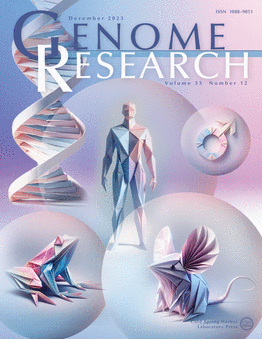Verkko2 integrates proximity ligation data with long-read De Bruijn graphs for efficient telomere-to-telomere genome assembly, phasing, and scaffolding
IF 6.2
2区 生物学
Q1 BIOCHEMISTRY & MOLECULAR BIOLOGY
引用次数: 0
Abstract
The Telomere-to-Telomere Consortium recently finished the first truly complete sequence of a human genome. To resolve the most complex repeats, this project relied on the semi-manual combination of long, accurate PacBio HiFi and ultra-long Oxford Nanopore sequencing reads. The Verkko assembler later automated this process, achieving complete assemblies for approximately half of the chromosomes in a diploid human genome. However, the first version of Verkko was computationally expensive and could not resolve all regions of a typical human genome. Here we present Verkko2, which implements a more efficient read correction algorithm, improves repeat resolution and gap closing, introduces proximity-ligation-based haplotype phasing and scaffolding, and adds support for multiple long-read data types. These enhancements allow Verkko to assemble all regions of a diploid human genome, including the short arms of the acrocentric chromosomes and both sex chromosomes. Together, these changes increase the number of telomere-to-telomere scaffolds by twofold, reduce runtime by fourfold, and improve assembly correctness. On a panel of 19 human genomes, Verkko2 assembles an average of 39 of 46 complete chromosomes as scaffolds, with 21 of these assembled as gapless contigs. Together, these improvements enable telomere-to-telomere comparative genomics and pangenomics, at scale.Verkko2整合了近端连接数据和长读De Bruijn图,用于高效的端粒到端粒基因组组装、分相和脚手架
端粒到端粒联盟最近完成了第一个真正完整的人类基因组序列。为了解决最复杂的重复序列,该项目依赖于长、准确的PacBio HiFi和超长Oxford Nanopore测序读数的半人工组合。Verkko组装器后来自动化了这一过程,实现了二倍体人类基因组中大约一半染色体的完整组装。然而,Verkko的第一个版本在计算上是昂贵的,并且不能解决一个典型的人类基因组的所有区域。在这里,我们提出了Verkko2,它实现了更有效的读取校正算法,提高了重复分辨率和间隙关闭,引入了基于邻近连接的单倍型相位和脚手架,并增加了对多种长读数据类型的支持。这些改进使Verkko能够组装二倍体人类基因组的所有区域,包括顶心染色体的短臂和两性染色体。总之,这些变化使端粒到端粒支架的数量增加了两倍,运行时间减少了四倍,并提高了组装的正确性。在一组19个人类基因组中,Verkko2将46条完整染色体中的39条平均组装为支架,其中21条组装为无间隙组合体。总之,这些改进使端粒到端粒比较基因组学和泛基因组学得以大规模实现。
本文章由计算机程序翻译,如有差异,请以英文原文为准。
求助全文
约1分钟内获得全文
求助全文
来源期刊

Genome research
生物-生化与分子生物学
CiteScore
12.40
自引率
1.40%
发文量
140
审稿时长
6 months
期刊介绍:
Launched in 1995, Genome Research is an international, continuously published, peer-reviewed journal that focuses on research that provides novel insights into the genome biology of all organisms, including advances in genomic medicine.
Among the topics considered by the journal are genome structure and function, comparative genomics, molecular evolution, genome-scale quantitative and population genetics, proteomics, epigenomics, and systems biology. The journal also features exciting gene discoveries and reports of cutting-edge computational biology and high-throughput methodologies.
New data in these areas are published as research papers, or methods and resource reports that provide novel information on technologies or tools that will be of interest to a broad readership. Complete data sets are presented electronically on the journal''s web site where appropriate. The journal also provides Reviews, Perspectives, and Insight/Outlook articles, which present commentary on the latest advances published both here and elsewhere, placing such progress in its broader biological context.
 求助内容:
求助内容: 应助结果提醒方式:
应助结果提醒方式:


